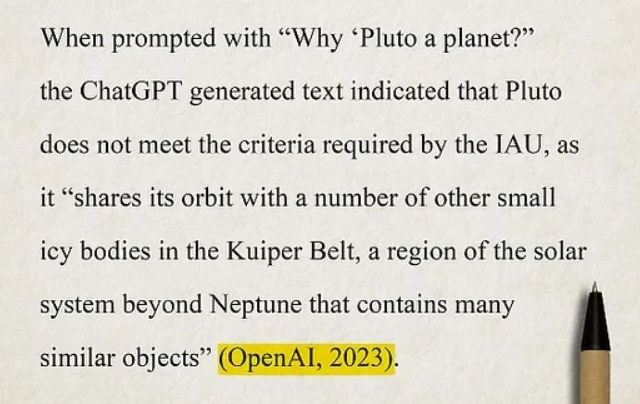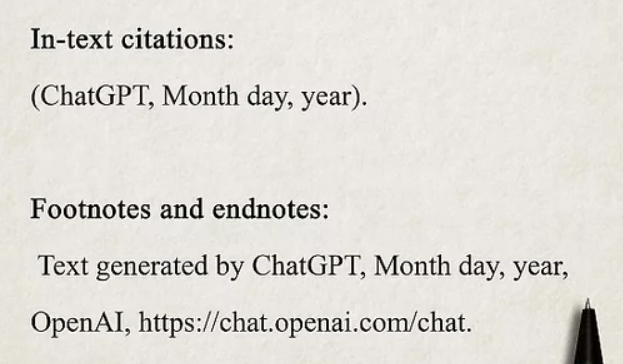So you’ve discovered the awesome power of ChatGPT for writing essays, emails, and even short books. There are many things you can do with ChatGPT but here comes the curveball: how to cite ChatGPT in your writing? It sounds straightforward until you realize there’s no universally accepted manual for it yet.
Given that we’re navigating uncharted waters here, let’s toss out the old playbook.
Remember when citing sources was as easy as looking up guidelines in your trusty APA or MLA handbook? Those days are gone when we talk about artificial intelligence inputs.
And while ChatGPT can generate text that feels like it came straight out of Hemingway’s typewriter (not really, but close enough), citing it correctly is crucial for maintaining credibility and transparency in your work.
Let’s review how to cite ChatGPT in your writing.
Table Of Contents:
- Why is It Important to Cite ChatGPT?
- When Should You Cite ChatGPT?
- What is The Difference Between MLA and APA Style?
- How to Cite ChatGPT in MLA and APA Formats
- How to Cite ChatGPT in Chicago Style
- How to Quote ChatGPT
- Conclusion
Why is It Important to Cite ChatGPT?
Whether you’re writing an academic paper or a blog post, citing sources properly is the cornerstone of ethical practice. This holds especially true when you are incorporating insights from generative AI tools like ChatGPT into your work.
As these technologies become more integrated into our research processes, understanding why we need to give credit to AI-generated content is crucial for maintaining integrity in digital communication.
Citing ChatGPT or any other LLM is important for these key reasons:
- Ethical Considerations: At its core, citation is about giving credit where it’s due. Just as you would acknowledge human authors for their contributions to your knowledge base, acknowledging the role of AI in generating content or ideas respects intellectual honesty standards.
- Maintaining Transparency: In an era where misinformation can spread rapidly online, being transparent about the origins of your information — including whether it was generated by an AI — helps build trust with your audience. It reassures them that you’re committed to accuracy and accountability in your content creation process.
- Fostering Academic Integrity: For students leveraging ChatGPT’s capabilities for academic purposes, citing these tools appropriately prevents issues related to plagiarism and maintains the credibility of their scholarly work. Educational institutions increasingly seek clarity on how students incorporate generative AI outputs into their assignments while upholding academic values.
To navigate this emerging landscape responsibly, guidelines on how to cite ChatGPT correctly have become indispensable resources for both educators and learners alike.
Recognizing the contributions of chatbots and language models shows that we’re all about pushing boundaries while keeping it ethical in any professional setting.
Further reading: What is ChatGPT and how does it work?
When Should You Cite ChatGPT?
In scenarios where ChatGPT or any similar tool provides substantial information, insights, or language that significantly shapes your final piece, citing this contribution becomes essential.
When is it proper to cite ChatGPT?
- Ideation: If an AI tool played a key role in generating topic ideas or outlining structures that guided your writing process.
- Data Generation: When using data or specific information provided directly by an AI platform to support arguments or claims within your work.
- Language Assistance: For instances where large portions of text are suggested by an AI which you then incorporate into your own writings without significant alteration.
What is The Difference Between MLA and APA Style?
The primary distinction lies in their application: Modern Language Association (MLA) is often used in humanities disciplines such as literature and cultural studies, where a more narrative style of citation complements analytical essays on texts or concepts.
In contrast, the American Psychological Association (APA) is commonly used by writers and students in the social sciences, behavioral sciences, and business. APA Style focuses on date of publication and authorship clarity, which serves well for scientific papers where source reliability and freshness are paramount.
How to Cite ChatGPT in MLA and APA Formats
Citing ChatGPT in MLA and APA format requires a slightly different approach compared to traditional sources.
Here’s a step-by-step guide for both styles:
MLA Format:
- Author: Since ChatGPT is an AI model created by OpenAI, there isn’t a single human author to attribute it to. Therefore, you’ll list the corporate author.
- Title: The title should be the name of the AI model, which is “ChatGPT.”
- Publisher: The publisher would be OpenAI.
- Publication Date: You can use the year when the model was publicly released or the year of the latest update.
- Medium: For the medium, you can specify “AI model” or “Artificial Intelligence.”
- Location: Since ChatGPT is an online resource, you can include the URL where it can be accessed.
Following these steps, here’s how you would cite ChatGPT in MLA format:
ChatGPT, AI conversational agent, version 4. OpenAI, 14 March 2024. Web.

Images from WikiHow
APA Format:
In-Text Citation: Mention ChatGPT and the date of communication in your text, rather than as a formal reference entry.
Example for in-text citation:
…according to OpenAI’s ChatGPT (2024) …

Reference List Entry (if applicable): If you believe the interaction with ChatGPT should be included in the reference list (e.g., if a transcript is publicly accessible), format it as follows:
- Author: Start with “OpenAI” as the author.
- Year: Include the year of your interaction in parentheses.
- Title: Use “ChatGPT interaction” followed by the date of the interaction.
- Format: Specify the format as “[Online forum comment].”
- URL: If available, include the URL where the interaction can be accessed.
Example for reference list entry:
OpenAI. (2024). ChatGPT interaction on 14 March 2024 [Online forum comment]. Retrieved from http://example.com
How to Cite ChatGPT in Chicago Style
The Chicago Manual of Style does not mandate a formal citation for content generated by AI tools such as ChatGPT. Simply acknowledging that an AI tool created part of your content will suffice.
For example:
Based on insights from industry leaders … [Generated by ChatGPT].
In cases where a more formal acknowledgment is required — either by professors or certain publications — the Chicago Manual suggests adapting existing citation formats to fit the unique nature of AI contributions.
Here’s how you could structure such a citation:
- Mention directly within your text that an AI tool was used (as previously noted).
- Include a footnote or endnote specifying details about the tool, for example: “The poem presented was generated using OpenAI’s GPT-3 technology.”
- If relevant and available, provide any URLs leading back to information about the specific use case or session with the tool (while ensuring user privacy).

These examples should serve as a general guide. Always refer to your institution’s specific requirements and the context of your work when citing sources.
How to Quote ChatGPT
Quoting your conversation with ChatGPT is similar to quoting a traditional published source.
- Credit the “author,” which in this case is ChatGPT, and OpenAI (the brains behind it) as the publisher.
- Note down when exactly you received that information.
- If possible, mention where that conversation happened (URL).
Conclusion
Learning how to cite ChatGPT properly is not just a technical requirement but a good, ethical practice for any writer using AI to create content.
Citing ChatGPT ensures transparency and integrity in our research and writing processes, affirming the credibility of our work by attributing ideas and insights to their sources, whether human or artificial.
Acknowledging ChatGPT also fosters a culture of respect for intellectual property rights and encourages responsible engagement with AI technologies.
As writers, it’s our responsibility to uphold the principles of academic integrity and give credit where credit is due, ensuring that every voice, human or machine, is acknowledged and valued.
